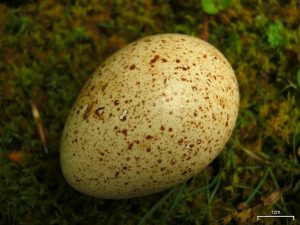
By Jason Hollinger (Wild Turkey Egg)
Collecting Turkey Eggs
Collect eggs twice a day and keep records of sizes, frequency, and the number of good poults produced from each pen in a season
How Many Eggs do Turkeys Lay?
Lighter breeds can lay up to 100 eggs in a season and come into lay earlier, whereas the heavier types may lay as few as 50, with the laying season lasting from 16 to 20 weeks. Laying begins at around 28 weeks onwards, depending on the breed.
When do Turkeys Lay Eggs?
Turkeys normally lay between April and June although there may be some eggs laid in March and July, with the earliest eggs producing the heaviest birds at Christmas.
Increasing Turkey Egg Production – Artificial Light
Providing artificial light early in the season may be needed as laying birds need about fourteen hours of light per day. It need not be much extra light, and a low wattage bulb over a pen is sufficient. It should have a timer so that the amount of light can be programmed, unless it is a digital system that calculates the amount of light automatically and compensates accordingly.
Start with lighting at the beginning of February, adding an extra hour each week so that there is a total of fourteen hours (artificial + natural) by early March. In a good year, a breeding pen of ten layers should produce more than 500 eggs.
Additional Profit from Turkeys
If you hatch more than you need, the surplus can be sold as poults, although it makes sense to sell to those outside the immediate area, who might otherwise end up as competitors. This will add to the profitability of the enterprise.
Incubating Turkey Eggs
Fertile eggs can be incubated naturally by the bird or artificially using a purpose-made incubator
Using a Broody Turkey Hen
As with chickens, turkey hens can go broody. They do not make particularly good mothers, although there are always exceptions. On the whole, it is better to use an incubator for incubating and hatching the eggs.
A broody turkey will take over a nest box and refuse to budge, complaining when anyone tries to move her. If broodiness is not required, the best thing is to remove her to a small, cool coop within sight of the breeding pen. She can stay there with food and water until the broodiness has gone. This could take a week or two. When she is no longer broody return her to active service in the breeding pen.
Artificial Incubation of Turkey Eggs
Store the eggs for the incubator in a cool pantry, broad end up in cartons for no more than a week before incubating them. Allow them to get to room temperature before introducing them into the machine and dip them in an egg sanitant to help ensure that they are free of pathogens. Turkey eggs are equivalent in size to duck eggs.
The longer eggs are kept before incubation, the lower the rate of hatchability, with the reduction amounting to around 2% per day after lay. Every egg should be clean, free from cracks or other surface damage and not misshapen.
The incubator must also be clean, disinfected and already running at the required temperature before introducing the eggs. It should be set up in a place where there is very little outside variation in temperature. A spare room in the house or a specially insulated area of a shed will suffice.
An automatic incubator will maintain the correct temperature and humidity and also turn the eggs regularly. Ensure that the manufacturer’s instructions are followed for there are slight variations with different models.
The optimum temperature at the centre of the egg is 37.5 O C, with a humidity level of 55% for the incubation period.
After a week remove the eggs one by one and candle them. This will show up those eggs that are not fertile and will also reveal whether the humidity level is correct from the size of the air sac. Discard the infertile eggs, returning the others immediately.
Around day 25 the eggs will begin to pip and the temperature should be reduced to 37.0 O C with the humidity increased to 75%. The eggs should hatch by day 28. Once dry, fluffed up and active, the newly hatched poults will need warmth, chick crumbs and water in a place protected from rats. (See Page 36). For a comprehensive coverage of incubation, see Incubation: A Guide to Hatching and Rearing.
This article is a shortened extract from Starting with Turkeys by Katie Thear and used with permission of the publisher.
Further Articles on Keeping Turkeys
- Breeding Turkeys – Genetics & Stock
- Breeding Turkeys – Incubating & Hatching Turkey Eggs
- Breeding Turkeys – Introducing Sexes & Mating Turkeys
- Breeding Turkeys – Turkey Rearing: Good Stock
- Guide to Keeping Turkeys – Housing & Feeding Turkeys
- Guide to Keeping Turkeys – Introduction & Turkey Breeds
- Guide to Keeping Turkeys – Turkey Diseases
- Guide to Keeping Turkeys – Turkey Health
- Guide to Keeping Turkeys – Turkey Parasites & Poison

